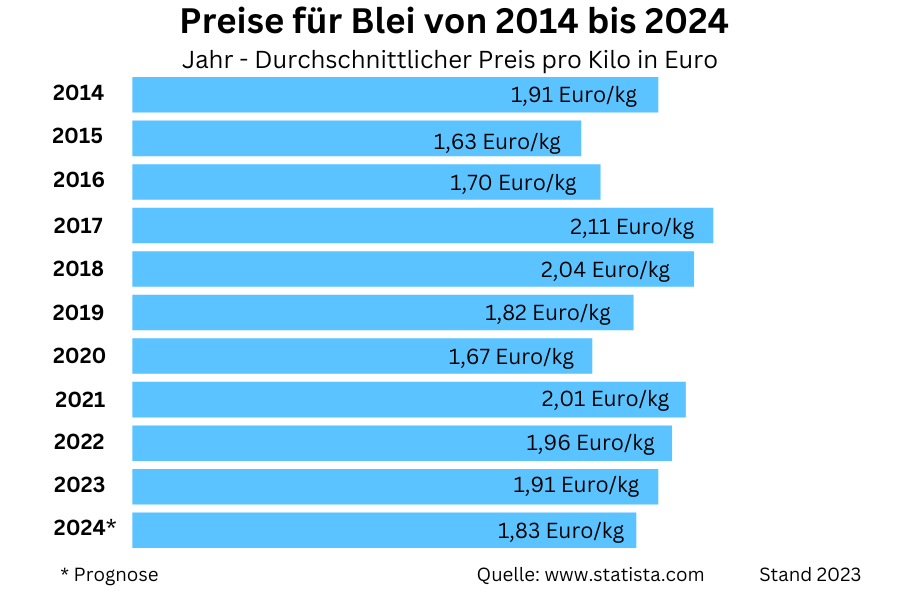What do you currently get for a kilo of lead?

Depending on the type of lead, the current price per kilo is between 20 cents and 2 euros. Since lead is relatively heavy, even small quantities can achieve a respectable selling price.
For example, a meter of lead pipe weighs up to three kilograms. When renovating old water pipes in an old building, a considerable amount of lead quickly accumulates.
In our table you will find the current lead prices in euros per kilo.
Table of current scrap prices for lead
| Art | Average price per kilo in euros |
|---|---|
| Old lead soft, soft lead | 1.50–1.55 euros/kg* |
| Balancing lead, balancing weights | 0.45–0.50 euros/kg* |
| Lead batteries | 0.35 euros/kg* |
| Cable peeling lead | 1.26–1.34 euros/kg* |
* Prices depend on quantity and location. There is a possibility that larger quantities can potentially achieve higher prices.
How much money do I get for old lead?
The more lead scrap you sell, the higher the prices scrap dealers typically pay for it. It may therefore be worthwhile to collect the old lead over a longer period of time as long as this does not incur additional storage costs.
Overview of the different types of lead in the scrap trade
Old lead
Lead pipes were previously installed in many houses because it was not yet known that the highly toxic lead leached into drinking water. Unfortunately, lead pipes are still found when renovating private houses because the owners have not taken care of them for many decades.
Old lead pipes belong to the “old lead” category. You can easily tell whether the pipes are actually old lead pipes using special test pens from the hardware store or specialist retailer. If the pen tip changes color, it is lead.
Lead was also previously used instead of tin for dishes, art objects and toys to save costs. You can read how to distinguish lead from tin and zinc on our current subpage tin prices.
Balancing lead & balancing weights
Car repair shops and tire dealers regularly produce large quantities of lead balancing weights at the change of season. But divers also use lead weights to make it easier to descend into the water.
Since these old balancing weights can be easily recycled, scrap dealers pay up to 40 cents per kilo for them. This scrap category includes deposits of iron allowed.
Lead batteries
There is a large amount of lead scrap in vehicle batteries. You can recognize a lead-acid battery by the Pb marking.
It is important to dispose of old lead batteries properly as they contain some substances that can harm the environment.
That is why, since 2009, the legislature has stipulated that a deposit of 7.50 euros must be paid when purchasing a new car battery. This amount will be refunded upon return to the retailer. Therefore, you should keep the receipt after purchasing a battery.
As a dealer, you can sell the returned lead batteries profitably on the scrap market.
Cable peeling lead
Some copper cables were previously coated with lead. Thanks to modern insulation, this is no longer necessary these days. For better recycling, the lead shell is separated from the copper core. These lead residues are referred to as “cable peeling lead”.
If you go to the work of peeling old lead-copper cables, you can sell the lead they contain separately from the copper. This means you get a higher overall scrap price.
When handling highly toxic lead, please remember to wear appropriate protective gloves.
Many scrap dealers also accept unsealed lead-copper cables. For these you will receive around 30 cents to 40 cents per kilo. You can find more information about lead-copper cables on our current subpage copper prices.
How are lead prices developing?
Since lead is primarily needed in the automotive industry to produce car batteries, current lead prices are heavily influenced by demand for vehicles.
This means that when the vehicle industry is doing well, lead prices also rise. The of Figures collected by Statista show that in 2018, 240,000 tons of lead were consumed by the domestic automotive industry in Germany alone.
Price development for lead in recent years
The lead industry's strong dependence on the automotive industry became apparent in 2015, when lead prices collapsed by almost 15 percent due to the sharp decline in demand for vehicles in China and other emerging countries.
From 2016, the expansion of e-mobility increased the demand for lead batteries for e-bikes and electric cars.
The Corona crisis led to a slight price decline of 6 percent, from which the lead industry quickly recovered. The economic recovery after the pandemic caused a brief price jump above the 3 euro mark in 2022.
Due to increased energy and transport costs, the price of lead is expected to remain high in the next few years. However, as production volumes increase worldwide, the oversupply of lead will slow further price increases.
Increasing competition from lithium-ion batteries will certainly pose a challenge for the lead industry in the future. It remains to be seen how much market share will be lost as a result.
Overview of lead prices from 2014
| Year | Average price per kilo in euros |
|---|---|
| 2014 | 1.91 euros/kg |
| 2015 | 1.63 euros/kg |
| 2016 | 1.70 euros/kg |
| 2017 | 2.11 euros/kg |
| 2018 | 2.04 euros/kg |
| 2019 | 1.82 euros/kg |
| 2020 | 1.67 euros/kg |
| 2021 | 2.01 euros/kg |
| 2022 | 1.96 euros/kg |
| 2023 | 1.91 euros/kg |
| 2024* | 1.83 euros/kg |
* Forecast
Be safe when handling lead
Since lead is highly toxic, you should store the heavy metal so that children and pets do not come into contact with it. If you must handle lead, you should always wear appropriate gloves.
